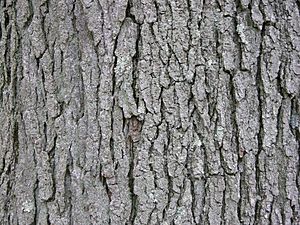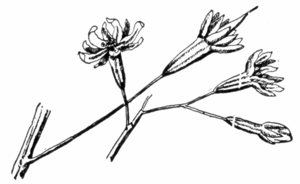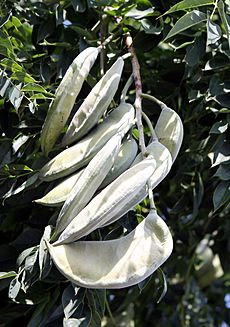Kentucky coffeetree facts for kids
Quick facts for kids Kentucky coffeetree |
|
|---|---|
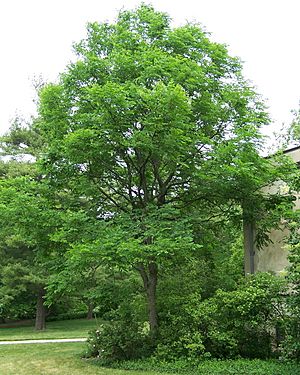 |
|
| Gymnocladus dioicus | |
| Conservation status | |
| Scientific classification | |
| Kingdom: | |
| (unranked): | |
| (unranked): | |
| (unranked): | |
| Order: | |
| Family: | |
| Subfamily: | |
| Genus: |
Gymnocladus
|
| Species: |
G. dioicus
|
| Binomial name | |
| Gymnocladus dioicus (L.) K. Koch
|
|
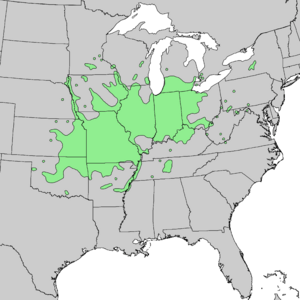 |
|
| Natural range | |
| Synonyms | |
|
|
The Kentucky coffeetree, also known as Gymnocladus dioicus, is a type of tree. It belongs to the pea family, called Fabaceae. This tree naturally grows in the Midwest and Upper South parts of North America.
People sometimes roast the seeds of this tree to use as a coffee substitute. However, it's very important to know that the unroasted pods and seeds are poisonous! The wood from the tree is strong and is used by cabinetmakers and carpenters. You can also see it planted as a street tree in many cities.
From 1976 to 1994, the Kentucky coffeetree was the official state tree of Kentucky. After that, the tulip poplar became the state tree again.
Contents
About the Kentucky Coffeetree
This tree usually grows to be about 18 to 21 meters (60–70 feet) tall. Its branches can spread out 12–15 meters (40–50 feet) wide. The trunk can be up to one meter (3 feet) across.
The Kentucky coffeetree grows at a medium speed. It can get taller by 30 to 60 centimeters (12 to 24 inches) each year. A young tree that is 10 years old will be about 4 meters (13 feet) tall.
Unique Features of the Tree
The tree often divides into three or four main branches about 3 to 4.5 meters (10–15 feet) from the ground. These branches form a narrow, pyramid-like top. If other trees are close by, it might grow one tall, straight trunk up to 15–21 meters (50–70 feet) high.
The branches are thick and do not have many small twigs. This makes the tree look "naked" for a long time, especially in winter. This is why its Greek genus name, Gymnocladus, means "naked branch." The French in Canada even called it "Chicot," which means "stubby."
The leaves of the Kentucky coffeetree are quite interesting. When they first appear, they are bright pink! As they get older, they change from green to bronze. In the fall, they turn a bright, clear yellow.
Bark and Wood
The bark of the tree is ash-gray and scaly. It flakes off, similar to a black cherry tree. The wood is light brown, heavy, and strong. It's also known to last a long time, even when it touches the ground.
Flowers and Fruit
Kentucky coffeetrees have separate male and female trees. This is called being dioecious. The female trees produce large, woody pods. These pods are filled with a sweet, thick, sticky pulp and hard-shelled beans. The pods can be 12 to 25 centimeters (5 to 10 inches) long. If a female tree isn't fertilized, it might grow smaller pods without seeds.
The flowers appear in June and are greenish-white. The female flowers are longer, about 20 to 30 centimeters (8 to 12 inches) long, and smell nice. The male flowers are about half that size.
Where the Tree Grows
The Kentucky coffeetree is considered a rare tree species. This means it's not very common, and its numbers are watched to make sure they don't get too low. Even though it's rare, it grows in many different places.
Natural Habitat
You can find this tree from southern Ontario in Canada, all the way down to northern Louisiana in the United States. It also grows from Kentucky and western Pennsylvania in the east, to Kansas and South Dakota in the west.
These trees usually grow alone or in small groups. They often have roots that are connected underground. You'll find them in areas that flood, like river valleys. Sometimes, they also grow on rocky hillsides or in woods with limestone.
Scientists believe this tree is an example of "evolutionary anachronism." This means it has features that were useful in the past but not so much now. For example, its tough seed pods are hard for many animals to open. They are also too heavy for wind or water to carry far. It's thought that very large animals, like mammoths, used to eat these pods. Their big teeth would help break open the seeds, allowing them to grow. Because those large animals are gone, the tree now mostly grows well in wet areas. In these places, the pods can rot away, letting the seeds sprout.
How People Use the Tree
Growing the Tree
The Kentucky coffeetree is a good choice for city environments. It can grow well even in poor soil and can handle very dry conditions. It also doesn't get many serious insect problems or diseases. Because of this, it's often planted in gardens and parks as an ornamental tree.
Its leaves appear late in spring and fall early. Also, because its leaves are large, it doesn't have many small twigs in winter. This makes it a great tree for city shading, especially where you want more sunlight in winter, like near solar heating systems.
You can easily grow Kentucky coffeetrees from their seeds. If you gently file the hard seed coat and then soak the seeds in water for 24 hours, they will sprout quickly. You can also grow new trees from root cuttings taken in winter.
Food and Safety
Native American tribes, like the Meskwaki and Pawnee, used to eat the roasted beans of the Kentucky coffeetree. They also ground the roasted seeds to make a hot drink, similar to coffee. Early European settlers copied this idea, especially when they couldn't get real coffee. However, they usually thought it wasn't as good as actual coffee.
It's very important to be careful: unroasted or only partly roasted beans and pods are poisonous! They contain a substance called cytisine. Roasting the pods and seeds helps to remove this toxic substance. The tree is also harmful to some animals.
Other Uses
Besides food, Native Americans used the seeds for games and jewelry. The seeds were often used as dice in games of chance. The fact that Native Americans used and moved these trees likely helped them spread to different areas.
The wood of the Kentucky coffeetree is used by both cabinetmakers and carpenters. It has very little sapwood, which is the softer, outer part of the wood.
Famous Kentucky Coffeetrees
- A very tall Kentucky coffeetree, about 26 meters (85 feet) high, was once in France. It was cut down in the 20th century.
- In London, UK, there's a Kentucky coffeetree in Mountsfield Park that is said to have been brought there in 1812.
- The largest Kentucky coffeetree in Texas is in Will Rogers Park in Amarillo, Texas. It's 51 feet tall and has a wide crown.
- You can find a Kentucky coffeetree at the Roger Williams Park Zoo in Providence, Rhode Island.
- At the U.S. Space & Rocket Center in Huntsville, Alabama, there are 19 Kentucky coffeetrees planted in the Apollo courtyard.
See also
 In Spanish: Cafetero de Kentucky para niños
In Spanish: Cafetero de Kentucky para niños



